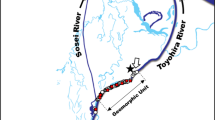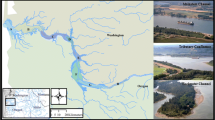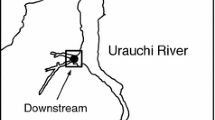Abstract
Short-term otolith growth rates, residence times, and forage of two species of juvenile salmon (Oncorhynchus spp.) were compared in a created and natural estuarine slough on the Chehalis River in Washington to assess the functional equivalency of the created slough in providing suitable rearing habitat. Otolith microstructure, mark-recapture data, and forage of sub-yearling chinook, O. tshawytscha, and coho, O. kisutch, residing in both sloughs during the spring of 1991 and 1992 served as indicators of rearing habitat quality. No significant differences in the number or width of coho daily otolith increments were detected between the sloughs. Juvenile chinook residence and emigration times were also comparable. Aquatic and terrestrial insects composed the majority of all chinook and coho diets; however, the order of importance of main prey items did differ between sloughs, and salmon in the created slough had emptier stomachs, possibly because of reduced prey availability and/or foraging efficiency.
Similar content being viewed by others
Literature Cited
Abrahams, M. V. and L. M. Dill. 1989. A determination of the energetic equivalence of the risk of predation. Ecology 70:999–1007.
Boule, M. E. and K. F. Bierly. 1986. History of estuarine wetland development and alteration: What have we wrought? Northwest Environmental Journal 3:43–61.
Bradford, M. J. and G. H. Geen. 1987. Size and growth of juvenile chinook salmon back-calculated from otolith growth increments, p. 453–461. In R. C. Summerfelt and G. E. Hall (eds.), Age and Growth of Fish. Iowa State University Press. Ames, Iowa.
Bradford, M. J. and G. H. Geen. 1992. Growth estimates from otolith increment widths of juvenile chinook salmon (Oncorhynchus tshawytscha) reared in changing environments. Journal of Fish Biology 41:825–832.
Brothers, E. B. 1990. Otolith marking. American Fisheries Society Symposium 7:183–202.
Campana, S. 1990. How reliable are growth back-calculations based on otoliths? Canadian Journal of Fisheries and Aquatic Science 47:2219–2227.
Campana, S. 1992. Measurement and interpretation of the microstructure of fish otoliths, p. 59–71. In D. K. Stevenson and S. E. Campana (eds.), Otolith Microstructure Examination and Analysis. Canadian Special Publication Fisheries Aquatic Science 117.
Campana, S. and J. D. Neilson. 1985. Microstructure of fish otoliths. Canadian Journal of Fisheries and Aquatic Science 42:1014–1032.
Chapman, D. W. 1962. Aggressive behavior in juvenile coho salmon as a cause of emigration. Journal of the Fisheries Research Borad of Canada 19:1047–1080.
Congelton, J. L., S. K. Davis, and S. R. Foley. 1981. Distribution, abundance, and outmigration timing of chum and chinook salmon fry in the Skagit salt marsh, p. 153–163. In E. L. Brannon and E. O. Salo (eds.), Salmon and Trout Migratory Behavior Symposium. University of washington, Seattle, Washington.
Dill, L. M. and A. H. G. Fraser. 1984. Risk of predation and the feeding behaviour of juvenile coho salmon (Oncohynchus kisutch). Behavior, Ecology, and Sociobiology 16:65–71.
Fisher, J. P. and W. G. Pearcy. 1990. Distribution and residence times of juvenile fall and spring chinook salmon in Coos Bay, Oregon. Fisheries Bulletin 88:55–58.
Francis, R. I. C. C. 1990. Back-calculation of fish length: A critical review. Journal of Fish Biology 36:883–902.
Francis, M. P., M. W. Williams, A. C. Pryce, S. Pollard, and S. G. Scott. 1993. Uncoupling of otolith and somatic growth in Pagrus auratus (Sparidae). Fisheries Bulletin 91:159–164.
Hare, J. A. and R. K. Cowen. 1995. Effect of age, growth rate, and ontogeny on the otolith size-fish size relationship in blue-fish, Pomatomus saltatrix, and the implications for back-calculation of size in fish early life history stages. Canadian Journal of Fisheries and Aquatic Sciences 52:1909–1922.
Healey, M. C. 1980. Utilization of the Nanaimo River Estuary by juvenile chinook salmon (Oncorhynchus tshawytscha). Fisheries Bulletin 77:653–668.
Healey, M. C. 1982. Juvenile Pacific salmon in estuaries: The life support system, p. 315–341. In V. S. Kennedy (ed.), Estuarine Comparisons, Academic Press, New York.
Hurlbert, S. H. 1978. The measurement of niche overlap and some relatives. Ecology 59:67–77.
Iwata, M. and S. Komatsu. 1984. Importance of estuarine residence for adaptation of chum salmon (Oncorhynchus keta) fry to seawater. Canadian Journal of Fisheries and Aquatic Science 41:744–749.
Johnson, S. W., J. F. Thedinga, and K. V. Koski. 1992. Life history of juvenile ocean-type chinook salmon (Oncorhynchus tshawytscha) in the Situk River, Alaska. Canadian Journal of Fisheries and Aquatic Science 49:2621–2629.
Johnsson, J. I. and M. V. Abrahams. 1991. Interbreeding with domestic strain increases foraging under threat of predation in juvenile steelhead trout (Oncorhynchus mykiss): An experimental study. Canadian Journal of Fisheries and Aquatic Science 48:243–247.
Kentula, M. E. 1986. Wetland creation and rehabilitation in the Pacific Northwest, p. 119–128. In R. Strickland (ed.), Wetland Functions, Rehabilitation, and Creation in the Pacific Northwest: The State of our Understanding Washington State Department of Ecology. Olympia, Washington.
Levings, C. D., C. D. McAllister, and B. D. Cheng. 1986. Differential use of the Campbell River estuary, British Columbia, by wild and hatchery-reared juvenile chinook salmon (Oncorhynchus tshawytscha). Canadian Journal of Fisheries and Aquatic Science 43:1386–1397.
Levings, C. D., C. D. McAllister, J. S. Macdonald, T. J. Brown, M. S. Kotyk, and B. A. Kask. 1989. Chinook salmon (Oncorhynchus tschawytscha) and estuarine habitat: A transfer experiment can help evaluate estuary dependency, p. 116–122. In C. D. Levings, L. B. Holtby, and M. A. Henderson (eds.), Proceedings of the National Workshop on Effects of Habitat Alteration on Salmonid Stocks. Canadian Special Publication of Fisheries and Aquatic Science 105.
Levy, D. A. and T. G. Northcote. 1982. Juvenile salmon residency in a marsh area of the Fraser River estuary. Canadian Journal of Fisheries and Aquatic Science 39:270–276.
Macdonald, J. S., C. D. Levings, C. D. McAllister, U. H. M. Fagerlund, and J. R. McBride. 1988. A field experiment to test the importance of estuaries for chinook salmon (Onco rhynchus tshawytscha) survival: Short-term results. Canadian Journal of Fisheries and Aquatic Science 45:1366–1377.
Maillet, G. L. and D. M. Checkley. 1990. Effects of starvation on the frequency of formation and width of growth increments in sagittae of laboratory-reared Atlantic menhaden, Brevoortia tyrannus, larvae. Fisheries Bulletin 88:155–165.
Marshall, S. L. and S. S. Parker. 1982. Pattern identification in the microstructure of sockeye salmon (Oncorhynchus nerka) otoliths. Canadian Journal of Fisheries and Aquatic Science 39: 542–547.
Mason, J. C. and D. W. Chapman. 1965. Significance of early emergence, environmental reating capacity, and behavioral ecology of juvenile coho salmon in stream channels. Journal of Fisheries Research Board of Canada 22:173–190.
Miller, J. A. 1993. Juvenile chinook (Oncorhynchus tshawytscha) and coho (O. kisutch) salmon in natural and created estuarine habitats: Foraging and daily growth. M. S. Thesis, University of Washington, Seattle, Washington.
Molony, B. W. and J. H. Choat. 1990. Otolith increment widths and somatic growth rate: The presence of a time-lag. Journal of Fish Biology 37:541–551.
Mosegaard, H., H. Svendang, and K. Taberman. 1988. Uncoupling of somatic and otolith growth rates in Arctic char (Salvelinus alpinus) as an effect of differences in temperature response. Canadian Journal of Fisheries and Aquatic Science 45: 1415–1524.
Mugiya, Y. 1987. Phase difference between calcification and organic matrix formation in the diurnal growth of otoliths in the rainbow trout, Salmo garidnerii. Fisheries Bulletin 85:395–401.
Mugiya, Y. and H. Oka. 1991. Biochemical relationship between otolith and somatic growth in the rainbow trout Oncorhynchus mykiss: Consequence of starvation, resumed feeding, and diel variations. Fisheries Bulletin 89:239–245.
Murphy, M. L., J. F. Thedinga, and K. V. Koski. 1988. Size and diet of juvenile Pacific salmon during seaward migration through a small estuary in southeastern Alaska. Fisheries Bulletin 86:213–222.
Neilson, J. D. and G. H. Geen. 1982. Otoliths of chinook salmon: Daily growth increments and factors influencing their production. Canadian Journal of Fisheries and Aquatic Science 39: 1340–1347.
Neilson, J. D. and G. H. Geen. 1985. Effects of feeding regimes and diel temperature cycles on otolith increment formation in juvenile chinook salmon, Oncorhynchus tshawytscha. Fisheries Bulletin 83:91–101.
Neilson, J. D., G. H. Geen and D. Bottom. 1985. Estuarine growth of juvenile chinook salmon (Oncorhynchus tshawytscha) as inferred from otolith microstructure. Canadian Journal of Fisheries and Aquatic Science 42:899–908.
Pannella, G. 1971. Fish otoliths: Daily growth layers and periodical patterns. Science 173:1124–1127.
Parker, R. R. 1962. Estimates of ocean mortality rates for Pacific salmon (Oncorhynchus). Journal of the Fisheries Research Board of Canada 19:561–589.
Parker, R. R. 1968. Marine mortality schedule of pink salmon of the Bella Coola River, central British Columbia. Journal of the Fisheries Research Board of Canada 25:757–794.
Peterman, R. M. 1978. Testing for density-dependent marine survival in Pacific salmonids. Journal of the Fisheries Research Board of Canada 35:1434–1450.
Pinkas, L., M. S. Oliphant, and I. L. K. Iverson. 1971. Food habits of albacore, bluefin tuna, and bonito in California waters. California Fish and Game Fisheries Bulletin 152:1–105.
Reimers, P. E. 1973. The length of residence of juvenile fall chinook salmon in the Sixes River, Oregon, p. 1–43. In R. T. Gunsolous (ed.), Research Reports of the Fisheries Commission of Oregon. Vol. 4, no. 2. Portland, Oregon.
Ryall, R. and C. D. Levings. 1987. Juvenile salmon utilization of rejuvenated tidal channels in the Squamish estuary, British Columbia. Canadian Manuscript Report of Fisheries and Aquatic Science 1904.
Rylko, M. and L. Storm. 1991. How much mitigation are we requiring? p. 314–327. In Puget Sound Research `91 Proceedings. Puget Sound Water Quality Authority. Seattle, Washington.
Secor, D. H. and J. M. Dean. 1992. Comparison of otolithbased back-calculation methods to determine individual growth histories of larval striped bass, Morone saxatilis. Canadian Journal of Fisheries and Aquatic Science 49:1439–1454.
Secor, D. H., J. M. Dean, and R. B. Baldevarona. 1999. Comparison of otolith and somatic growth in larval and juvenile fishes based on otolith length/fish length relationships. Rapports et Proces-Verbaux des Reunions Conseil International pour l’Exploration de la Mer 191:431–438.
Secor, D. H., J. M. Dean, and E. H. Laban. 1992. Otolith removal and preparation for microstructural examination, p. 19–57. In D. K Stevenson and S. E. Campana (eds.), Otolith Microstructure Examination and Analysis. Canadian Special Publication of the Journal of Fisheries and Aquatic Science 117.
Shreffler, D. K., C. A. Simenstad, and R. M. Thom. 1990. Temporary residence by juvenile salmon in a restored estuarine wetland. Canadian Journal of Fisheries and Aquatic Science 47: 2079–2084.
Shreffler, D. K., C. A. Simenstad, and R. M. Thom. 1992. Foraging by juvenile salmon in a restored estuarine wetland. Estuaries 15:204–213.
Simenstad, C. A., J. R. Cordell, W. G. Hood, J. A. Miller, and R. M. Thom. 1992. Ecological status of a created slough in the Chehalis River estuary: Report of monitoring in created and natural estuarine sloughs, January–December 1991. University of Washington, Fisheries Research Institute, FRI-UW-9206. Seattle, Washington.
Simenstad, C. A., J. R. Cordell, J. A. Miller, W. G. Hood, and R. M. Thom. 1993. Ecological status of a created slough in the Chehalis River estuary: Report of monitoring in created and natural estuarine sloughs, January–December 1992. University of Washington, Fisheries Research institute, FRI-UW-9305. Seattle, Washington.
Simenstad, C. A., K. L. Fresh, and E. O. Salo. 1982. The role of Puget Sound and Washington coastal estuaries in the life history of Pacific salmon: An unappreciated function, p. 343–364. In V. S. Kennedy (ed.), Estuarine Comparisons. Academic Press, New York.
Simenstad, C. A. and R. M. Thom. 1992. Restoring wetland habitats in urbanized Pacific Northwest estuaries, p. 423–472. In G. W. Thayer (ed.), Restoring the Nation’s Marine Environment, Maryland Sea Grant, College Park, Maryland.
Solazzi, M. F., T. E. Nickelson, and S. L. Johnson. 1991. Survival, contribution, and return of hatchery coho salmon (Oncorhynchus kisutch) released into freshwater, estuarine, and marine environments. Canadian Journal of Fisheries and Aquatic Science 48:248–253.
Thayer, G. W. (ed.) 1992. Restoring the Nation’s Marine Environment. Maryland Sea Grant, College Park, Maryland.
Thedinga, J. F. and K. V. Koski. 1984. A stream ecosystem in an old-growth forest in southeast Alaska. Part VI: The production of coho salmon, Oncorhynchus kisutch, smoths and adults from Porcupine Creek, p. 99–108. In W. R. Meehan, T. R. Merrel, Jr., and T. A. Hanley (eds.), Proceedings From a Symposium on Fish and Wildlife Relationships in Old-growth Forests. American Institute of Fisheries Research and Biology, Juneau, Alaska.
Tschaplinski P. J. 1982. Aspects of the population biology of estuarine-reared and stream-reared juvenile coho salmon in Carnation Creek: A summary of current research, p. 289–307. In G. F. Hartman (ed.), Proceedings of the Carnation Creek Workshop: A Ten-Year Review. Malaspina College, Nanaimo, British Columbia.
Tschaplinski, P. J. 1987. The use of estuaries as rearing habitats by juwenile coho salmon, p. 123–141. In T. W. Chamberlin (ed.). Proceedings of the Workshop: Applying 15 Years of Carnation Creek Results. Pacific Biological Station. Nanaimo, British Columbia.
United States Army Corps of Engineers. 1989. Grays Harbor, Washington Navigation Improvement Plan. United States Army Engineer District, Seattle, Washington.
Volk, E. C., S. L. Schroder, and K. L. Fresh. 1990. Inducement of unique otolith banding patterns as a practical means to mass-mark juvenile Pacific salmon. American Fisheries Society Symposium 7:203–215.
Volk, E. C., R. C. Wissmar, C. A. Simenstad, and D. M. Eggers. 1984. Relationship between otolith microstructure and the growth of juvenile chum salmon (Oncorhynchus keta) under different prey rations. Canadian Journal of Fisheries and Aquatic Science 41:126–133.
Wilson, K. H. and P. A. Larkin. 1980. Daily growth rings in the otoliths of juvenile sockeye salmon (Oncorhynchus nerka). Canadian Journal of Fisheries and Aquatic Science 37:1495–1498.
Wydoski R. S. and R. R. Whitney. 1979. Inland Fishes of Washington, University of Washington Press, Seattle, Washington.
Zar, J. H. 1984. Biostatistical Analysis. Prentice Hall, Englewood Cliffs, New Jersey.
Zedler, J. B. 1988. Salt marsh restoration: Lessons from California, p. 69–85. In J. Cairns, Jr. (ed.), Rehabilitating Damaged Ecosystems, CRC Press, Boca Raton, Florida.
Author information
Authors and Affiliations
Rights and permissions
About this article
Cite this article
Miller, J.A., Simenstad, C.A. A comparative assessment of a natural and created estuarine slough as rearing habitat for juvenile chinook and coho salmon. Estuaries 20, 792–806 (1997). https://doi.org/10.2307/1352252
Received:
Accepted:
Issue Date:
DOI: https://doi.org/10.2307/1352252




